All the tips, tricks, charts, links, and handouts that can help you run the world’s greatest Role-Playing Game: Dungeons & Dragons! (But can be applied to any RPG.)

Dungeons & Dragons is one of the most enjoyable and original games ever invented. No other game is as creative, inventive and engaging as Dungeons & Dragons. Every game is unique and each session is custom-made to provide the maximum enjoyment for every player. And nothing is more fun and enjoyable than being the Dungeon Master. Nothing is as frustrating and aggravating as well, but that is a different topic.
Now I’m not here to convince you to play D&D or run D&D as the DM. I figure that if you’ve found this website, then you are down the rabbit hole already and are trying to make sense of it all. I am here to help. Consider me your hookah-smoking caterpillar, here to guide you and give you advice. Except, I don’t smoke and only have two legs. It’s a role-playing game; use your imagination.
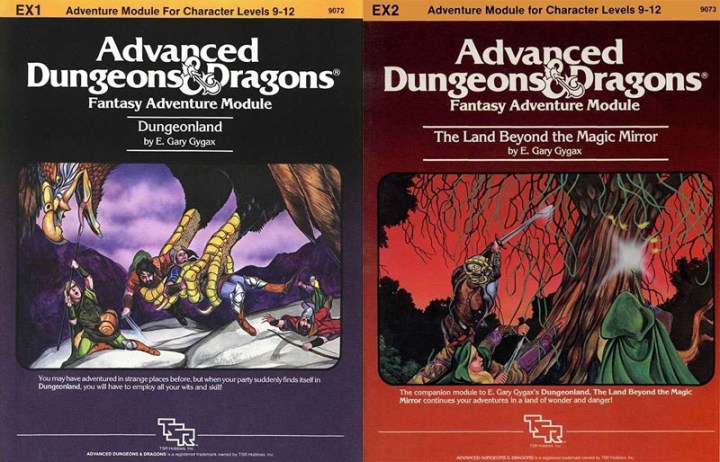
Enough of this banter, how do you present a rich, detailed world filled with excitment and danger, while keeping yourself sane and your notes intact? Let us begin.
Player Resources
Actually some of the best resources you can use are ones that you give out to the players. That’s right, place some of the burden of remembering everything onto them.
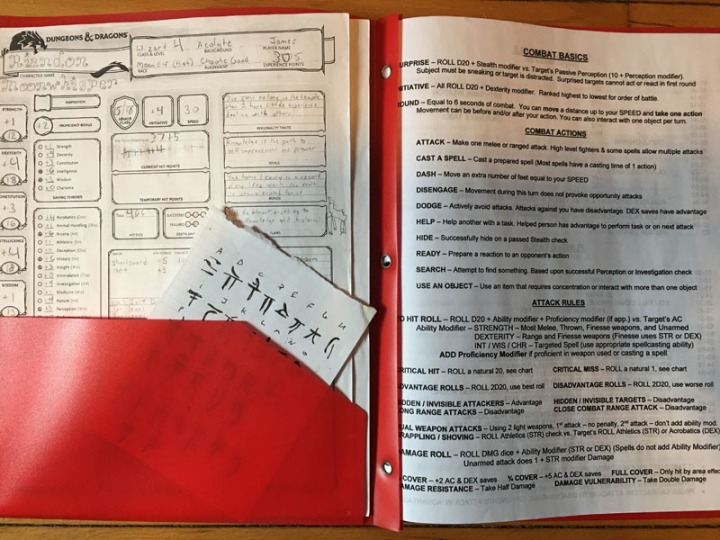
At the start of every campaign, I give each player a two-pocket folder with prongs for holding 3-hole-punched pages. The first pocket holds their character sheet, plus any spell and inventory sheets. The second pocket will hold any handouts given to the player. The sheets that go in the middle consist of all the Rules and World Synopses that will help them learn about the game and the campaign setting. All of the following links lead to PDF files for you to use in your own game.
Rules FOUR PAGE
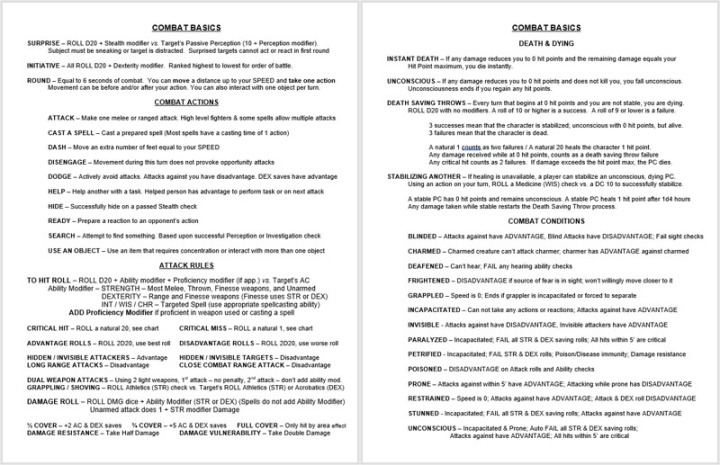
First, I gave my players a brief summary of adventuring and combat rules. This includes the basic adventuring rules covering Movement, Environment factors, Resting, and Exhaustion. The combat section includes rules for Surprise, Initiative, and available Combat Actions. It explains Advantage & Disadvantage, plus the factors that affect those rules. It also details the rules for Death & Dying, and lists all the various Combat Conditions.
These Rules Reminders are perfect for helping new players learn the game and are even useful for veteran players as well. And they are really good at helping you with those rarely used rules, such as exhaustion and cover. Rather than fumbling through the Player Handbook trying to find it, they are right there at your fingertips.
Critical Hit-Fumble Table
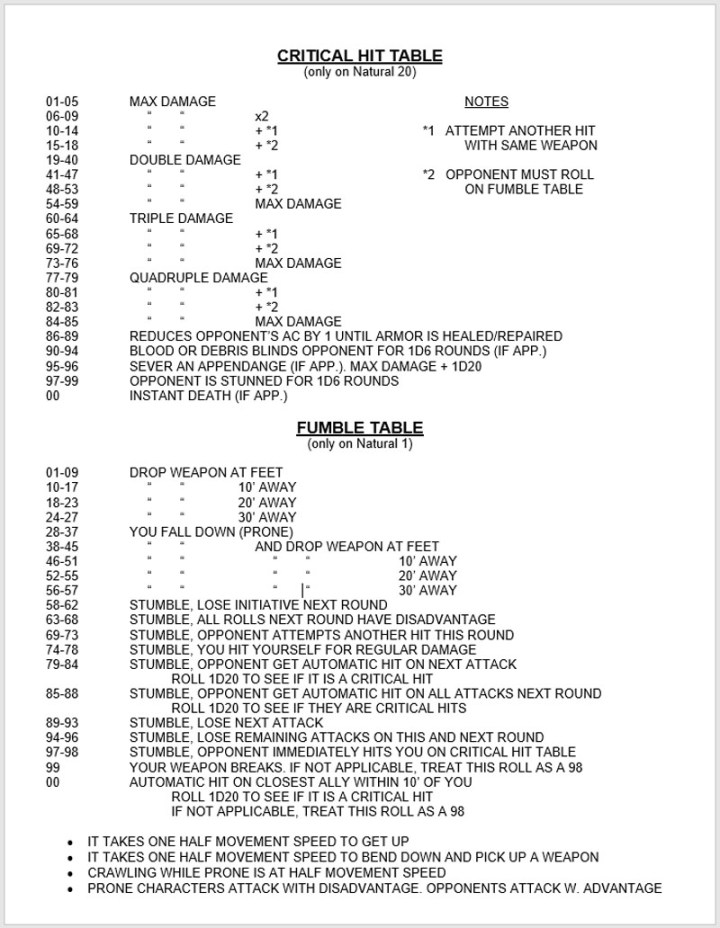
The last page of my Rules Synopsis is a homebrewed Critical Hit / Fumble chart. The 5th Edition rules on this topic are pretty dull (double damage for a critical hit / lose a turn on a fumble). This adds a lot more randomness and excitement to our combat. My players love rolling Nat 20s (and even 1s) and reaching for this chart. To them it’s like shooting craps; will they bust out or hit the jackpot? Granted, it is now possible for your BBEG to be killed by a single blow, but that’s a chance my players are willing to take. Even though this chart is included in my Rules Synopsis, several people have asked for it separately.
Equipment List & Equipment List Gear
I also give them a list of all the basic equipment commonly available for purchase within the world. These items and prices are taken directly from the Players Handbook. Sometimes it is fun to role play the shopping spree, but usually it is just easier and more efficient for them to look it up on their own and tell me what they bought. Obviously, prices can be adjusted, based upon the availability of the item and the quality of the shop. There are two files for these Equipment Lists.
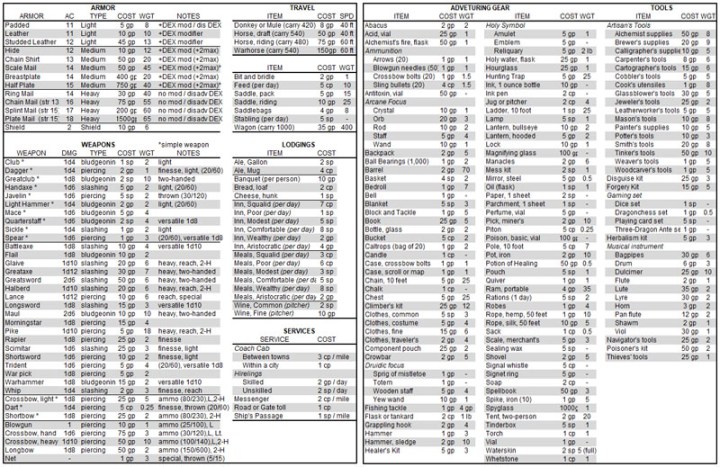
The next item I give to my players is based upon the World Setting of my (and hopefully your) campaign. Our campaign is set in the land of The Sword Coast in The Forgotten Realms, the offical setting of 5th Edition D&D and home to most of the published adventures.

Sword Coast Codex
This is a Setting Overview which informs the players of the common knowledge that any person who lives in the Forgotten Realms would know. It covers topics from basic geography, money, religion, and the calendar. It lists some of the factions operating in the world, plus a number of the major gods worshipped by the people. It also includes a (very brief) History of the Realms and a listing of the years that comprise the era of the 5th edition adventures. This is a great way to introduce your players to the lore of your world. This new Codex removes all references to any specific date, so that you can use it no matter what date, season, or year you want your campaign to begin. Below, in the Other Web Resources section, is a link to an excellent article that breaks down the timeline of all the official 5th edition adventures.

If you have your campaign taking place in a different setting, such as Greyhawk, Eberron, or even your own, then obviously this Codex will not work for you. But you can use this as the template from which to create your own. And if you are truly ambitious, you can use your Overview to drop a little foreshadowing into your camapign. For example, I’ve had my players discover the symbol for Talos, the evil god of chaos and ultimate villain, numerous times throughout our adventures and I’m just waiting for a player to find this reference in the codex. In addition, they are aware of a prophesy regarding “The Ageless One” which is also the named year of our campaign (1479 DR) as listed in the History section.
Dungeon Master Resources

Now lets talk about the DM resources, the secret stuff that the players can’t see. These are the charts and pages that hide behind your DM Screen, in fact one is attached directly to the screen, but we’ll get to that. Most of these are adventure specific, meaning you will have to have a unique, custom-made one for each adventure. But a couple are useful throughout the campaign, regardless of the adventure. And if you want to create your own charts, with the exception of the Party Stat Sheet, which was made in Microsoft Word, all of the charts were created using Excel.
Party Character Stats

This is really a Cheat Sheet that allows me to see all my players relevant statistics. I use this to help make my combat encounters more exciting and the role-playing more dramatic. Knowing their ability score modifiers tells me who is more likely to survive (or more importantly succumb to) a nasty spell or saving throw. Knowing their max hit point helps me keep my encounters balanced so that I don’t overwhelm my players with a random encounter or other shenanigan made up on the fly. Keeping a list of their skill abilities lets me tailor encounters so that the players can actually use them, and also makes the world seem more real when they fail at a skill they don’t have. The most important stat on the sheet is the Passive Perception. If I have to ask a player for this stat then I just indirectly told them that there is something nearby that needs to be perceived, ruining the whole purpose of this stat.
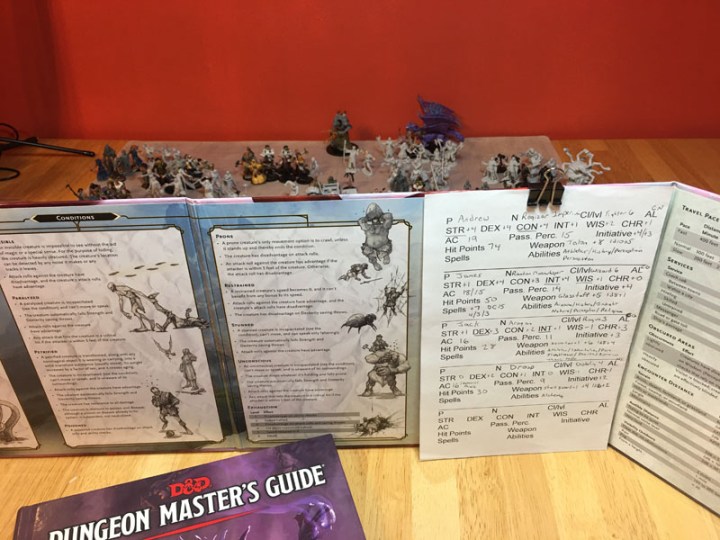
I fold or cut the sheet in half and it fits perfectly on the 5e Dungeon Master Screen. Since I have yet to run a game with more than 5 players, this has worked perfectly for me. It also lets me pencil in any NPC followers that happen to be along on the adventure. Of all the resources on this page, I’ve used this one the most, and in every session.
CHASE Tracking Sheet

The Dungeon Master’s Guide has some interesting (if not often used) rules for running a chase scenario which were put to great use in the adventure Waterdeep: Dragon Heist. So, when I had the opportunity to run a madcap chase along the rooftops and through the streets of Waterdeep, I created this Tracking Sheet to better keep track of all the distances, dashes used, and exhaustion levels. Chases can be fun and exciting for the players, while you get to play with math and bookkeeping. Hopefully this will help make your end of it a little bit easier and maybe even not tedious.
Someday, I’ll make a full post on running a chase encounter. For now, just refer to the DMG, but I do have a few tips. At the start, make sure that the quarry is far enough away from the party to stay ahead of the Monks and Thieves with their bonus Dash Actions (for a few rounds anyway). Also, I would rule that every use of the Dash action (including bonus actions), counts toward the total number of Dash actions allowed before rolling for exhaustion. This gives the player that burst of energy that might end a chase quickly, but at the risk of getting exhausted quicker. And keep good track of those exhasution levels, since once one side reaches level 2 the chase is basically over.

Since hazards are the best part of any chase, make sure you put several in the first few rounds (at least 3 in the first 6 rounds) to make the chase exciting right from the start. Keep track of where (in distance travelled) the quarry encounters a stationary hazard (like a wall or a pit) so that you can have the players overcome the same obstacle in the proper location. A lot of hazards list a failure penalty of “X feet of difficult terrain”. Rather than calculate all that (especially if the chase is already over difficult terrain), just subtract the listed number from the total move of the round. So, if a player dashing for 60 feet fails a 10′ wall hazard, then he gets over the wall but only moves 50′. Finally, never make the math more important than the action. Always keep it flowing, and when in doubt, rule in favor for the players. The chase is on!
Calendar Forgotten Realms
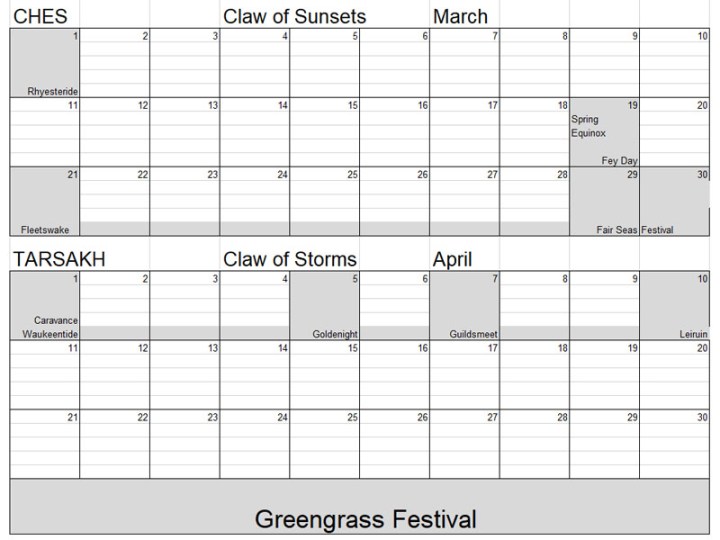
The Forgotten Realms setting has a very specific and unique calendar for marking the passage of time. It is closely aligned with our calendar, such that each of the 12 months has a real-world conterpart, but they all have different names and each month lasts 30 days which is divided into three 10-day “weeks” called a Ten-Day. Each month has their own set of unique holidays and there are five extra seasonal “Festival Days” which occur in between certain months. These holidays are all marked is grey, including a few holiday “ten-days” as you can see above.
I use the calendar to plot out the timeline of our campaign. Keeping track of travel times, months, seasons, and the bad guys timetables, lends verisimilitude to our fictional world. I often incorporate dramatic events to coincide with the various holidays to inject a a bit of local flavor or piece of lore into the encounter. Recently, my players stopped a plan to cause some chaos during the holiday of Dragondown, and before that they saved the village of Phandalin from a massive invasion that occurred during the Greengrass Festival. Of course, this calendar is very specific to the Forgotten Realms and may not be applicable to your game. If that is the case, I would recommend making a copy of your specific calendar.
Adventure Resources
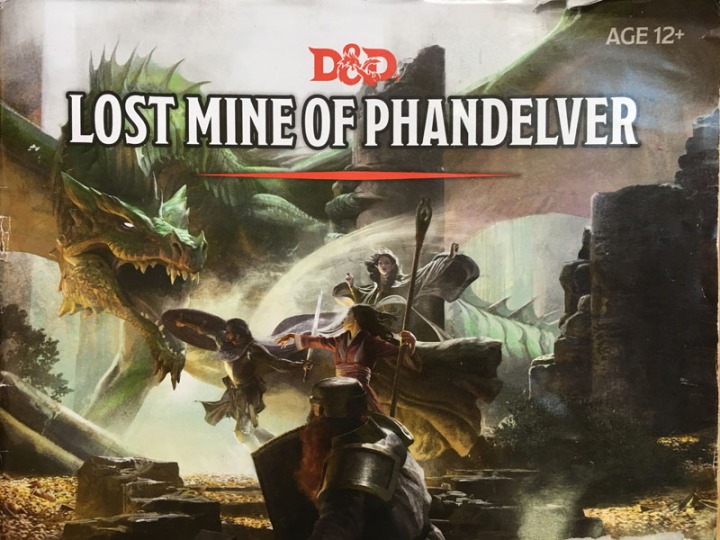
The remaining charts are all adventure specific and need to be custom made to suit your needs. In this post, the Title PDF link leads to a clean, blank version of the chart in question. But for the purposes of explaining them, I will show my examples from the Lost Mine of Phandelver adventure found in the Starter Set. I will include a link to the PDF of those charts as well. If you would like further context for those charts, please go to my Lost Mine of Phandelver Campaign Resources Page. If you would like more information on any of the other adventures that I have run please refer to my D&D Campaign Resources Page which lists all of the adventures we have played through, including LMOP.
Monster Stats Sheet Blank
One of the things that I loved most about the Old School adventure modules is the Monster Stats page. This was a page near the back of the module that simply listed all of the monsters (and NPCs) that could be encountered in the adventure with all of their significant statistics all in one place. It is the main thing that is sorely lacking in the current adventure books. No more searching the Monster Manual just to find a saving throw modifier. No more flipping back and forth between two separate pages if you try to run a multiple monster combat. A sheet like this saves you so much time and effort, allowing you to focus on the fun of the game and not the boring math.
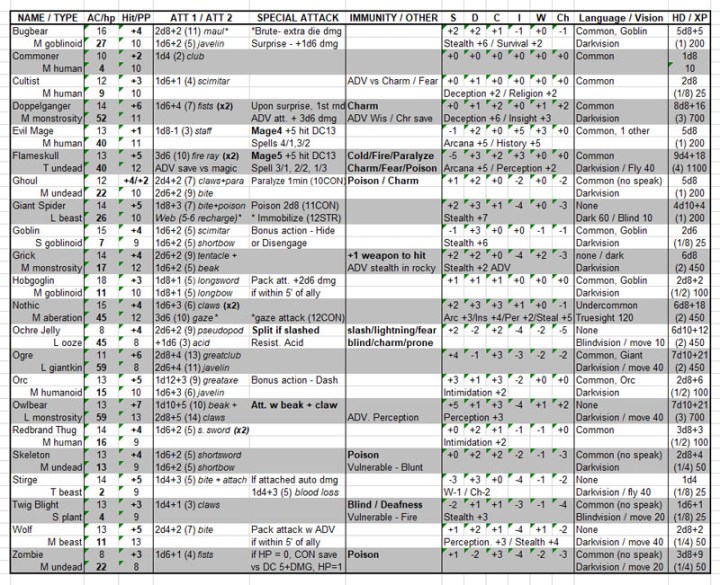
Most of the chart is self-explanatory, but just so there is no confusion, here is the rundown of all the stats. Every monster is listed using two rows. The first column is the Monster’s name followed by its size and creature type. The 2nd column is its Armor Class followed by its hit points which I type in bold. Next is the To Hit Modifier (also in bold) and its Passive Perception score. If the To Hit Modifier has two numbers, the second is for its secondary attack (often a range wepaon). The 4th column list the monster’s various Attacks including damage dice rolled (and average damage in paranthesis) and the weapon used. If there is a number such as (x2) in bold after the weapon that indicates that he has two attacks per round with that weapon. The fifth column lists any Special Attack or Abilities, such as breath weapons, posion damage, spell abilities, or anything else. Occasionally, these abilities have a ® symbol indicating a Reaction or a (b) indicating a bonus attaction. The next column lists any Immunities, Resistances, or Vulnerabilities. Immunities are usually listed in bold. Resistances are preceded by an “R” and Vulnerability is preceded by a “V”. If a creature rolls with with advantage, “ADV”, versus any attack or damage type, I include that here as well. The next columns are the monster’s Saving Throw Modifiers and I list any important skill modifiers here as well. The Languages & Vision column is obvious, but I also list any unique Move Speed here as well. The last column lists its Hit Dice in case you feel like having monsters with variable hit points instead of carbon copy bad guys. Finally, The Experience Point stat also lists its Challenge Rating in paraenthesis.
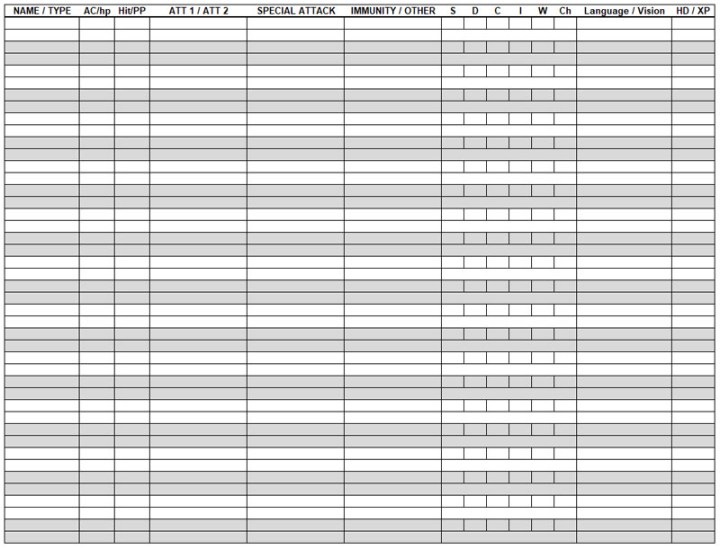
Encounter List Blank
In a similar vein, I use an Encounter List that includes a breakdown of every encounter location in the adventure. I often find that while it’s easy to find the boxed text describing a room (it’s in a big box!), when I am in the midst of roleplaying, I often misread or forget the details of the room, especially traps and hidden items. This chart allows me to see each dungeon room at a glance, reminding me of each location’s features. It also helps me plan out what minis I need for the session, dole out the proper amount of treasure, and count the exact experience points earned based upon which rooms they cleared.
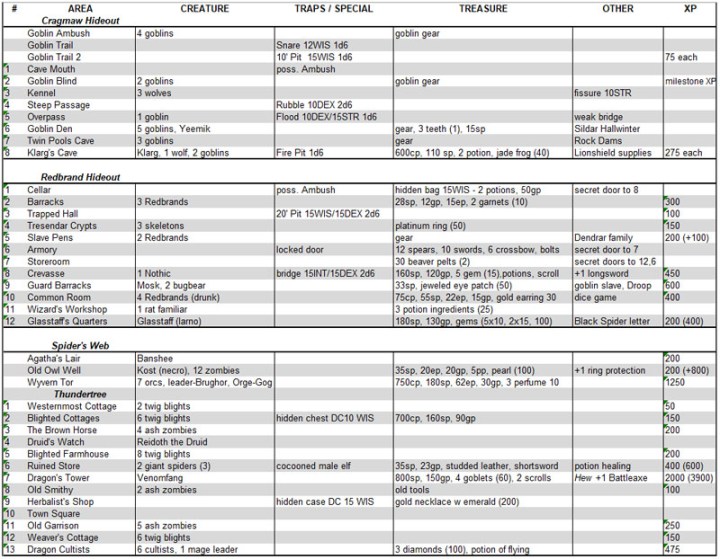
Again, most of this is self-explanatory, but there are a few details that might not be obvious. The Creature column includes anything that the PCs might be expected to engage in combat. In addition to traps, The Traps/Special column will include anything hidden or locked within the room. The Other column can include anything that didn’t fit in the other columns, such as secret doors, extra treasure, or non-combat NPCs, and handouts. The XP column includes the experience points earn for defeating every combatant in the room. The number in parenthesis is extra XP for fulfilling a certain condition, such as the +100 for rescuing the captives in Room 5 of the Redbrand Hideout, or the 400 XP earned for capturing Glassstaff alive in Room 12 of the same dungeon.

Village Roster Blank
For the last of my PDF charts, I write out a Village Roster for every occupant of the player’s home base. In the case of the Lost Mine of Phandelver, that is the village of Phandalin. The adventure book only describes a handful of NPCs; the innkeeper, a few shopkeeps, the mayor, and the single high-level retired adevnturer. For the most part, this will suffice. But occasionally a player will point to a random building and ask, “Who lives there?” The answer doesn’t matter, but telling him that will ruin the mystique of the game.
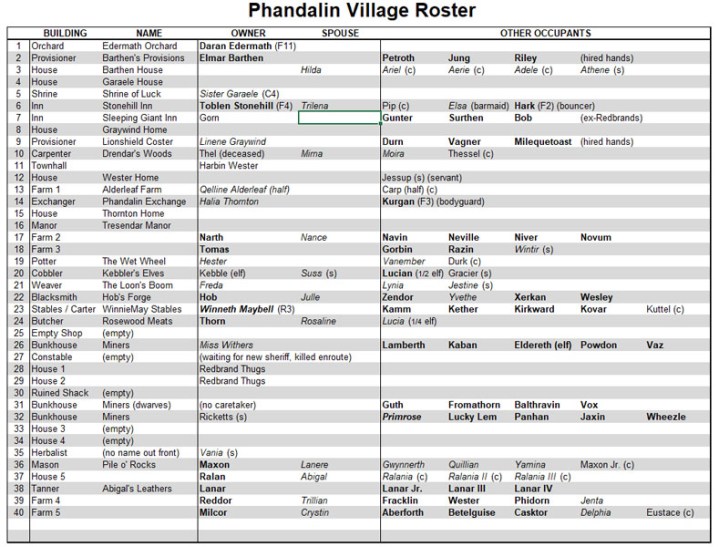
In the roster, names in italics are female, the symbol “(c)” indicates a child, and the symbol “(s)” is a senion citizen. A townsfolk with a number after his/her name, indicated a level adventurer, so “(F4)” would be a 4th level fighter. “C” is a cleric, and “R” is a ranger. Also, any name in bold indicates a citizen capable of fighting during the Goblin Invasion that occurred during our campaign. For my own amusement, I like to throw in some interesting details if you read between the lines. For instance, Location 38 is the Tanner’s Shop named Abigail’s Leathers, however Abigail lives with another man at Location 37. Or the elven cobbler, Kebble, who has an adult half-elf son named Lucian, but a few doors down the butcher and his wife have a single daughter, who is secretly of 1/4 elf heritage and is named Lucia.
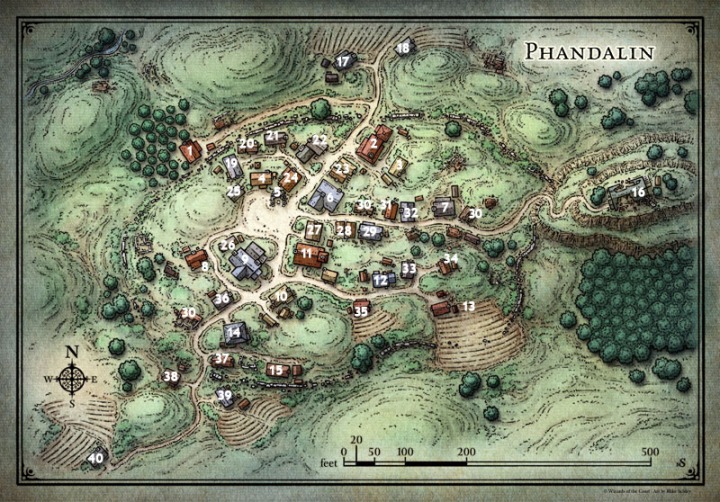
Of course, this expanded list will require you to add location numbers to all the remaining building of your village, as I’ve done here. I find that the 40 buildings that comprise the village of Phandalin to be the perfect level of detail. If your campaign involves a small town, you might only need to detail about half of it, and if your players live in a large city like Waterdeep, I would limit the area of detail to just a small neighborhood such as the 30 buildings that comprise Trollskull Alley from Dragon Heist.

Online Resources
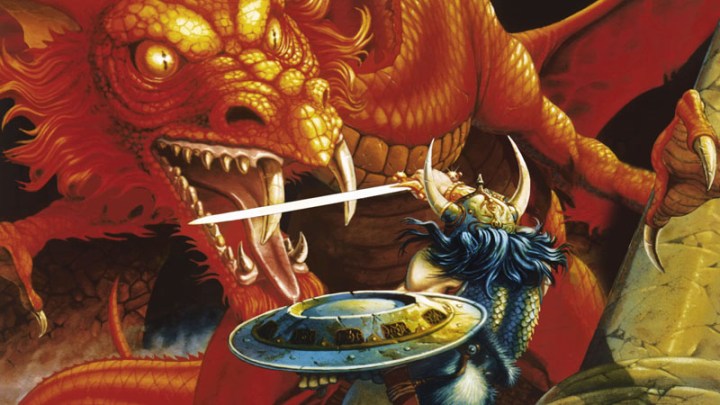
There are a number of excellent additional resources available online to help you be a better DM. Here are a few that I use all the time. I often keep the website tabs open on my phone or tablet to refer to them as needed during a game.
Websites
 Roll 20 D&D 5th Edition Compendeum – Roll 20 is one of the best virtual tabletop systems and they have compiled a complete listing of every rule, monster, spell, and more that is D&D. The link does offer virtual books for sale, but the entire database is fully searchable and completely free. Just use the Search Bar to type in whatever you need to find and get the full description and statistics of that item. This resource is invaluable.
Roll 20 D&D 5th Edition Compendeum – Roll 20 is one of the best virtual tabletop systems and they have compiled a complete listing of every rule, monster, spell, and more that is D&D. The link does offer virtual books for sale, but the entire database is fully searchable and completely free. Just use the Search Bar to type in whatever you need to find and get the full description and statistics of that item. This resource is invaluable.
 Forgotten Realms Wiki – Every article of fact, trivia, and lore relating to the Forgotten Realms (where the 5th edition adventures are set) can be found here. This is a tremendous source for inspiration to add favor and spice up your campaign. Perfect for researching the people, places, and events of the world’s greatest fantasy setting. I use this all the time.
Forgotten Realms Wiki – Every article of fact, trivia, and lore relating to the Forgotten Realms (where the 5th edition adventures are set) can be found here. This is a tremendous source for inspiration to add favor and spice up your campaign. Perfect for researching the people, places, and events of the world’s greatest fantasy setting. I use this all the time.
 Kobold Fight Club – Wandering Monsters are a staple of D&D. Nothing keeps players on their toes better than some random thing jumping out from the shadows. But the tables provided in most modules are pretty boring. Kobold Fight Club uses math, algorithms, and magic(?) to create memorable and unique random encounters for any level. Yip, yip, yip!
Kobold Fight Club – Wandering Monsters are a staple of D&D. Nothing keeps players on their toes better than some random thing jumping out from the shadows. But the tables provided in most modules are pretty boring. Kobold Fight Club uses math, algorithms, and magic(?) to create memorable and unique random encounters for any level. Yip, yip, yip!
![]() Drivethru RPG – This is an excellent source for finding all the OSR D&D adventures and modules from every edition, but especially 1st and 2nd edition. They mostly come in PDF format but some have a print on demand option. I have been replacing all of my original and lost D&D materials using this website. In the rare event that I can’t find what I need, I will use the Dungeon Masters Guild which is their sister site.
Drivethru RPG – This is an excellent source for finding all the OSR D&D adventures and modules from every edition, but especially 1st and 2nd edition. They mostly come in PDF format but some have a print on demand option. I have been replacing all of my original and lost D&D materials using this website. In the rare event that I can’t find what I need, I will use the Dungeon Masters Guild which is their sister site.
 Alphastream Gaming Blog – This is an excellent blog that also delves into various D&D and RPG topics. Among some terrific articles, Teos Abadia, who runs the site, has put together the definative timeline of all the 5th edition D&D Adventures. This can help you choose which adventure you might want to run.
Alphastream Gaming Blog – This is an excellent blog that also delves into various D&D and RPG topics. Among some terrific articles, Teos Abadia, who runs the site, has put together the definative timeline of all the 5th edition D&D Adventures. This can help you choose which adventure you might want to run.
YouTube Channels
There are a number of excellent YouTubers who produce good, useful content related to roleplaying games and D&D specifically. Here are a few of my favorites.
 Matthew Colville – This is by far and away, the best channel for getting advice about being a dungeon master. His series on Running the Game is phenomenal, and covers every topics from running a simple hack-and-slash dungeon to an open sandbox adventure and even a deep, sophisticated politcally-motivated Game of Thrones style campaign. His love of RPGs is evident in every syllable of every word. And the streaming of his actual gameplay sessions is the only one I can watch, even over Critical Roll! I would kill to play in his campaign.
Matthew Colville – This is by far and away, the best channel for getting advice about being a dungeon master. His series on Running the Game is phenomenal, and covers every topics from running a simple hack-and-slash dungeon to an open sandbox adventure and even a deep, sophisticated politcally-motivated Game of Thrones style campaign. His love of RPGs is evident in every syllable of every word. And the streaming of his actual gameplay sessions is the only one I can watch, even over Critical Roll! I would kill to play in his campaign.
 Seth Skorkowsky – This is a kick-ass site that dives into a ton of great stuff such as DM tips, player advice, RPG Philosophy, adventure reviews and overviews. He also discusses several other RPG systems, including Call of Cthulhu, Cyberpunk, and Star Traveller. His videos are always fun to watch and his interlaced skits are the only ones that are actually funny. Plus, I met him once and he is a truly great guy, so I’ll try to help him out. Not that he needs it. His channel just won an ENnie award for best online content!
Seth Skorkowsky – This is a kick-ass site that dives into a ton of great stuff such as DM tips, player advice, RPG Philosophy, adventure reviews and overviews. He also discusses several other RPG systems, including Call of Cthulhu, Cyberpunk, and Star Traveller. His videos are always fun to watch and his interlaced skits are the only ones that are actually funny. Plus, I met him once and he is a truly great guy, so I’ll try to help him out. Not that he needs it. His channel just won an ENnie award for best online content!
 Jorphdan – Jordan the ph is silent has one of the best channels that delves into the lore of the Forgotten Realms. He has plenty of other things on his channel, such as reviews and advice about the 5th edition D&D adventures, a series on creating your own world, and collaborations with other YouTubers. But it is his encyclopedic knowledge of the Forgotten Realms campaign setting is without equal. From the gods, factions, races, nations, geography, and history of the fabled land of Faerun, Jorphdan is the omnipotent god of trivia.
Jorphdan – Jordan the ph is silent has one of the best channels that delves into the lore of the Forgotten Realms. He has plenty of other things on his channel, such as reviews and advice about the 5th edition D&D adventures, a series on creating your own world, and collaborations with other YouTubers. But it is his encyclopedic knowledge of the Forgotten Realms campaign setting is without equal. From the gods, factions, races, nations, geography, and history of the fabled land of Faerun, Jorphdan is the omnipotent god of trivia.
 Capt Corajus -Pronounced Captain Courageous, this channel is an excellent place to learn about the Old School Revival that is finding its way into more and more D&D campaigns. Here you will find out about all the original D&DC adventures as well as ways to incorporate the elements of Old School style of play into your game. This is also where I stole the Game On! tag that ends all my posts.
Capt Corajus -Pronounced Captain Courageous, this channel is an excellent place to learn about the Old School Revival that is finding its way into more and more D&D campaigns. Here you will find out about all the original D&DC adventures as well as ways to incorporate the elements of Old School style of play into your game. This is also where I stole the Game On! tag that ends all my posts.
So, that’s about it. Hopefully, you can find something useful for you to use and help you better run your adventures. If there is anything else that you wish that I had included in this post, then send me a comment or email and I’ll see what I can do.
If you want to check out any more of the unique charts I use for a specific adventure then check out my D&D Campaign Resources Page.

As always, when all else fails and you lose your notes, just wing it. Your players will never know, and Game On! (Thanks, Captain!)

Reblogged this on DDOCentral.
LikeLike
Thanks for the great resources. I’m gearing up to run a Pro DM campaign online and I’m sure that these will be helpful.
LikeLiked by 1 person
You’re welcome. Are you running a written adventure or homebrew? What setting do you use? How does a pro DM campaign work? As a boomer who grew up playing in the 80s, paying someone to be the DM feels weird. Good luck.
LikeLike
Thanks I’m about to run this for similar aged kids. First Time involved in D& D for a while and this has been very helpful
LikeLiked by 1 person
I’m glad I could help. When I got back in the game, I knew 2nd edition rules and I felt like I had to learn it all over again. Good luck running the game with your kids.
LikeLike
Do you have any of these in an excel spreedsheet or google sheet?
LikeLiked by 1 person
I do have them on an excel spreadsheet. If I find a way to upload them to the site, I’ll include them. Thanks for digging the site.
LikeLike
Great stuff Rich. I’m prepping for running LMoP with the family, first time DMing. These things will help immensely. thanks for taking the time to share and make available the resources! Very much appreciated!
LikeLiked by 1 person
You’re very welcome. If you ever have a question, feel free to ask. Good luck with the game. Let me know how it goes.
LikeLike
I’m a beginner player in a beginner group and occasional one-shot wannabe DM when the full group isn’t around. This set of resources are great
LikeLiked by 1 person
Thanks Ben, I’m glad you liked it. Some good one-shots are Dead in Thay and Tomb of Horrors. Both in Tales from the Yawning Portal. Let me know how it goes.
LikeLike
Hey i just wanted to tell you as a first time DM your guides have been so extremely helpful
LikeLiked by 1 person
Thank you so much. That really means a lot. I happy that you find them useful. If you ever have a question, I’d me happy to make up an answer for you. Rich
LikeLiked by 1 person
Thank you very much. And I just want to tell you that all your comments and appreciation are incredibly motivating and inspiring, so Thank You!
LikeLike
Looking to run a family night game, first effort in 40 years – this is really helpful in getting comfortable and organized. I appreciate the work you have put into this!
LikeLiked by 1 person
I’m glad you liked it and welcome back. I;m always trying to improve these pages. If there is something you’d like to see on it, let me know.
LikeLike
Rich – In the Critical Hit and/or Fumble Table in your 4 page rules, what do the numbers on the far left mean?
LikeLike
Thank you for your well resourced pages. I am starting a campaign as a first time DM and the information is immensely helpful
LikeLike
Man amazing work.
LikeLiked by 1 person
Thanks, Harry. Is there anything you need that I could add to make it better?
LikeLike
Thank you for this site! It has helped me so much. I have all three of my kids playing and am looking forward to our next adventure!
LikeLiked by 1 person
I’m very happy that you liked it and that it has been helpful. I’m thrilled to hear about another family bonding over D&D. What adventure are you playing?
I’m always looking for more resources to include on the page. If you think of any, let me know. Until then, Game On!
LikeLike
What graph paper do you use for your battle maps? They seem much larger than 8.5″ x 11″, but maybe you just tape them together?
LikeLiked by 1 person
If I can’t fit what I need on my 24×20 dry mat, then I tape paper pages together. Thanks for asking.
LikeLike
Great resources! Thanks so much for taking the time to put all this together and help the community!
LikeLiked by 1 person
You’re welcome. A thank you for the appreciation
LikeLike
fantastic resources
do you have a spell casting basics one?
LikeLiked by 1 person
Not yet but that is a great idea. I work on it.
LikeLike
Would LOVE for an updated 4 page “adventuring basics” for the 5e 2024 changes!! I use that sheet all the time. It’s like a staple in me DMing ❤
-Chris
LikeLiked by 1 person
That’s a great idea. I work on that. Of course, now I’ll have to actually read the new books.
LikeLiked by 1 person
Can you please explain a little better on the Critical Hit-Fumble Table in the NAT20 section. What would be the difference between 06-09 (I read it as MAX DAMAGE X2) and 19-40 (DOUBLE DAMAGE)
Thank you!
LikeLiked by 1 person
So weird that you mention this. I haven’t used this table in my last two campaigns but wanted to use it for Strahd (coming soon) and I noticed the exact same issue. First off I stole this list from Seth Skorkowsky, so blame him and check out his YouTube channel. But to your question, let assume the normal damage is 1d8. Max damage x2 would be 16 points of damage + any combat modifier. Double damage would be to roll 1d8 and multiply by 2 making a range of 2-16. Hope this helps. Thanks for asking.
LikeLiked by 1 person